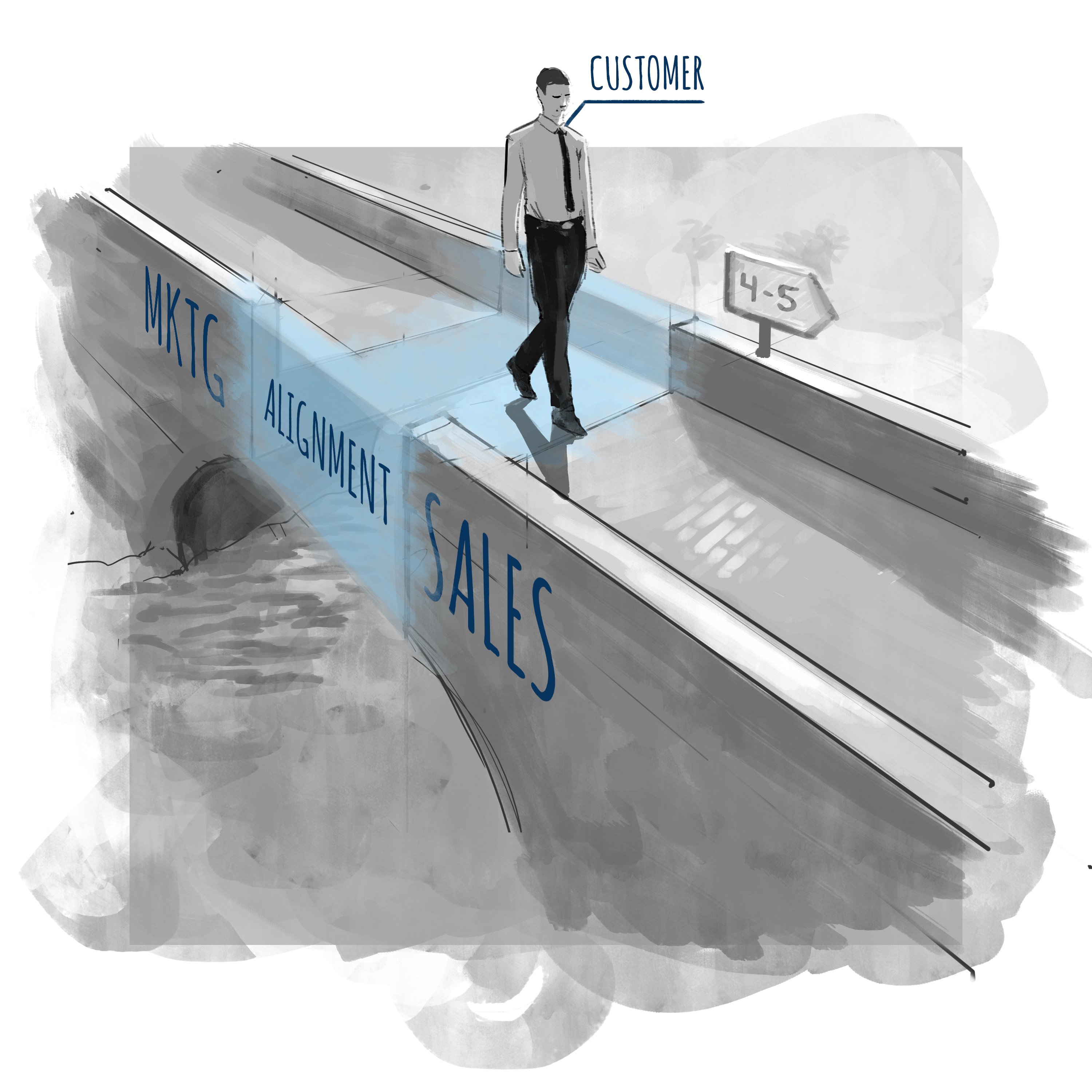
Sean Doyle
Sean is a principal at FitzMartin, and our leading mind and voice on sales and marketing strategy. Sean is particularly adept at applying the science of behavior change to the art of sales and marketing. It’s an approach that he and FitzMartin have developed over thousands of client engagements since 1992.
Never miss a post
Subscribe below to receive blog updates.
First, let’s recap the six stages of the customer decision journey and simplify things a bit. The first five stages lead you to an exchange, a closed deal. How to simplify those five steps? Focus on the four conversion points. The first conversion point is helping a person move from being unaware to thinking about a change.

The idea of a conversion point is that a prospect on a journey can be identified by their behavior and assigned to one of the six stages. We, as sales and marketing people, do not decide when a prospect moves from one stage to another; the buyer is in control. Our job is to help them move forward.
Most marketing is concentrated in the early stages of the sales cycle. Advertising. PR. Events. But the true power of marketing shows at the later stages, when prospects get closer to buying.
There are plenty of agencies that are skilled at creating awareness. We’re focusing this blog on the role that marketing plays in helping sales close deals. This kind of marketing is more subtle, more difficult to master.
Can we do the early-stage stuff, awareness and converting visitors to your site into leads? Sure. But we best serve companies that want help guiding those prospects through to close.
The Stage 4 Stage 5 Conversion: Where Your Work Pays Off
The stage 4-5 conversion is the very definition of late stage. Action to Exchange. You know where you want the prospect to land—they give you money, and you provide them with products or services in exchange. Let’s talk about where they are and how to help them move forward.
In the Action stage, your prospect is asking you directly for a proposal. They want to know the cost of change. Price is a bit more complicated than the cash exchange, however. Science tells us that a buyer (or in B2B, the group of buyers) sees the behavior change they are making has a cash AND personal cost. The personal cost could be measured in the time it takes the person or team to implement the change; it could be the cost of possible failure and how you will correct problems when things go wrong. After all, nothing in life is perfect; it’s all about how you will fix it. Is that defined in your marketing tool for late-stage buyers? When was the last time you defined the personal cost as such in your proposal?
So imagine this: The prospect has resources set. They’ve changed the way they talk about your service and/or product. Things like, “In the future, it will be great to have this problem solved. Can’t wait.” The deal is in hand, but then something happens. No deal. It gets pushed. And then pushed again.
Why?
When we conduct an audit, we often find answers to these late-stage fails. Typically, it involved marketing not knowing how to support sales, and sales assuming the deal is done. Let’s look briefly at a few highlights based on the four processes that science teaches us are effective at this point in the process.
Helping Relationships
It’s true. The best salespeople assist clients; they don’t manipulate them to close. But let’s also bring the power of marketing to the table. The science teaches us that a person going through behavior change is looking for help.
Assistance with budgeting and proposals is easy to spot. How about your influencer plan? Is one set? Have you mapped out the personal, strategic and financial needs of each influencer, and do you message for each?
Do you have defined tools to listen? We often keep talking when it is most wise to listen. Have you designed a program to offer early guidance and exposure to your expertise? It’s a fantastic tool to help close a deal.
Marketing can help in two ways. First, by designing and working with your sales team to create these tools and, second, to craft the communications tools for the team to use. This could be a webpage or paper tool, but it also could be as simple as a late-stage competitive analysis tool that allows your sales force to reassure the prospect’s decision to buy your product.
Positive Substitution
If you are helping someone to quit smoking, it is a common tactic to offer an alternative to the habit. “Try this gum, rather than quit all at once.” The gum is a substitute for the behavior you are trying to change.
Have you thought about how the process of buying from your competitor is a habit, albeit a wrong one? What needs to be done to make changing that habit easy?
It might be a simple plan, like the procurement-process design. Ask accounting, “Do you want us to bill you in a certain way? How should we code the invoice to make it easy for you?” You might uncover the cure to a pain that secures the love and support of accounting. Always smart. Design a path to behavior change; help prospects break their habits.
Environmental Control
Science shows if you want to help a friend quit drinking, do not take them to a bar! Logical. Getting your prospect out of the environment where they are used to buying from your competitor can help alter their behavior.
A simple sales trip to play golf or such make sense at this time. I know a contractor who flies prospects to an NFL stadium where he has a private box. What else? Tours of your facility. Disney gets this more than most. I am Disney-trained in experience design, and I’ve seen a properly designed plant tour flip the close rate of an entire organization.
How have you considered your experience design?
Rewards
Tricky, right? We are NOT saying kickbacks. We’re all about helping prospects, not bribing them. When we say reward good behavior, we are acknowledging that humans like to be rewarded. Since we were children. Consider how your buyer might like to be rewarded. Maybe a simple comment in front of the boss. Perhaps it is golf. Maybe it’s a thank you note. Every industry has its boundaries, and you need to work within those rules. However, do reward good behavior. Determine what those behaviors are, and then assign a reward. Set a meeting with me, you get a Starbucks card and a written thank you. Bring in all the decision-makers for a working session, let’s go to a nice dinner to plan out that meeting. You get it … just define it.
It’s rare to find a good marketer who wants to help this late-stage conversion to happen, but we are committed to it. Does your marketing team even know this should be done? Does sales trust marketing to help? If not, start there. Did you budget for this help? If, when we do audits, we see the money piled up on awareness tools, we always reassign some of the budget to later-stage tools.
How do you know what to do next? Try some of the ideas we outlined above. I’ll give you a framework so you can try it yourself. Look at your setup now, and see if gaps and barriers to sales are in place and decide how to fix those problems. It is often NOT about spending more money; it’s about being smarter.
Nothing Else Matters Until Something Gets Sold
If you want outside help, we do conduct audits. Shout, and we will share what that looks like. Of course, this is what we do, and we are always glad to help. In fact, if you want help, we want you to have enough safety to call us.
Our promise: If you’re going to explore more deeply, call and we will set you up with a video series that teaches this topic deeply. Alternatively, you can consider reading a book we wrote: SHIFT “A guide for executives in charge of marketing but not trained for the task.”
Then again, if you are ready for a guide through this … we will talk to you about that process, too.

